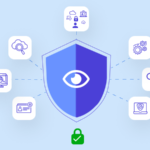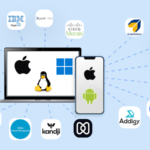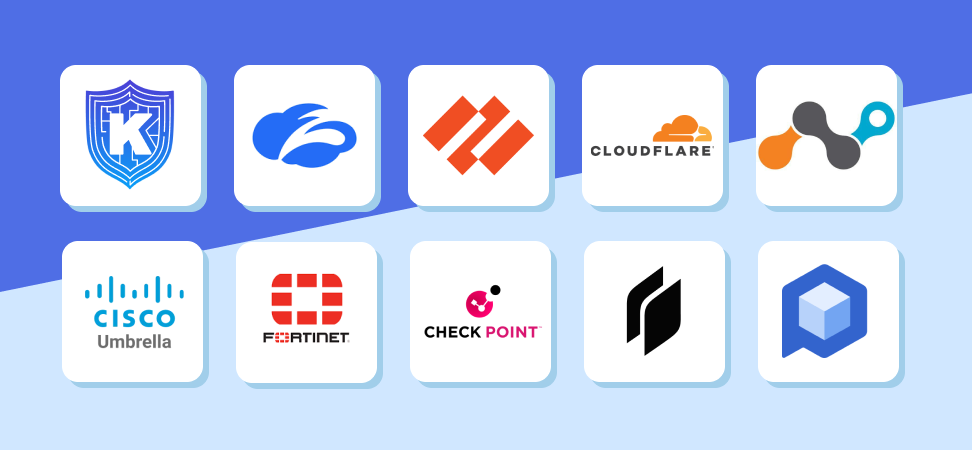Table Of Content
Top 10 ZTNA Solution Providers & Vendors for mac, Windows, and Linux Devices
-
October 1, 2025
-
Summary:The top Zero Trust Network Access (ZTNA) solutions for mac, Windows, and Linux in 2025 include Kitecyber Infra Shield, Zscaler Private Access, Palo Alto Prisma Access, Cloudflare Zero Trust, and Twingate. These platforms offer cross-platform agents, identity-based access, and AI-driven threat protection to replace legacy VPNs with secure, low-latency connections.
Too many options! That’s the headache security teams face when choosing a Zero-Trust Network Access (ZTNA) solution providers and vendors for 2025. Sorting real innovation from slick marketing isn’t easy. We get it, we’ve spent months wading through vendor decks, Reddit rants, G2 reviews, and price sheets to find the tools that actually cut risk.
Earlier this year, we ran a deep dive into the ZTNA market. We benchmarked features, crunched pricing, and interviewed admins who battle VPN sprawl every day. Since then, we’ve kept tabs on every product launch and roadmap shift to see which players deliver on the zero-trust promise across Mac, Windows, and Linux.
Now we’re sharing the 10 top ZTNA solutions and vendors that rose to the top of our 2025 watchlist (ranked, because you asked).
Let’s dive right in!
Earlier this year, we ran a deep dive into the ZTNA market. We benchmarked features, crunched pricing, and interviewed admins who battle VPN sprawl every day. Since then, we’ve kept tabs on every product launch and roadmap shift to see which players deliver on the zero-trust promise across Mac, Windows, and Linux.
Now we’re sharing the 10 top ZTNA solutions and vendors that rose to the top of our 2025 watchlist (ranked, because you asked).
Let’s dive right in!
Why Do Businesses Look for ZTNA Solutions Tailored for mac, Windows, Linux?
Businesses turn to ZTNA solutions to secure remote work across mac, Windows, and Linux devices, as hybrid environments blur network boundaries and expose vulnerabilities. Employees rely on Macs for creative tasks, Windows for enterprise applications, and Linux for development, but a single breach on any device could jeopardize your entire system. ZTNA replaces unreliable VPNs, which often suffer from connection drops and slow speeds on non-Windows platforms, by offering agent-based or agentless access for seamless, cross-platform performance. For cloud-native firms using AWS/ Azure or any multi-cloud infrastructure, ZTNA ensures secure access without exposing networks, supporting fast-flux domains and IPv6 across all operating systems. Key benefits include:
- Consistent, least-privilege access across laptops and cloud VMs, regardless of OS.
- Protection against credential-theft breaches by eliminating implicit network trust
- Faster onboarding for distributed teams, enabling connections in minutes without provisioning VPN subnets
Key Factors IT & Security Admins Must Look for to Evaluate ZTNA Vendors
- Evaluate scalability first: Your ZTNA vendor should handle growing users and devices without performance dips. Look for cloud-native architectures that scale globally.
- Check integration capabilities: The solution must work with your IAM, SSO, and SIEM tools. Seamless ties to Active Directory or Okta save time.
- Assess threat protection: Advanced features like DLP, ATP, and real-time monitoring are essential. Ensure it blocks malware and phishing across devices.
- Review visibility and reporting: Granular logs and analytics help spot anomalies quickly. Dashboards should offer context-aware insights.
- Consider deployment models :Agent-based for endpoints or service-initiated for third parties? Hybrid options provide flexibility.
- Factor in user experience :Low latency and easy setup matter for adoption. Support for mac, Windows, Linux is non-negotiable.
- Examine cost and support :Pricing should align with value. Look for responsive teams and automation.
Top 10 ZTNA Solutions and Vendors in 2025
1. Kitecyber Infra Shield (ZTNA Solution)
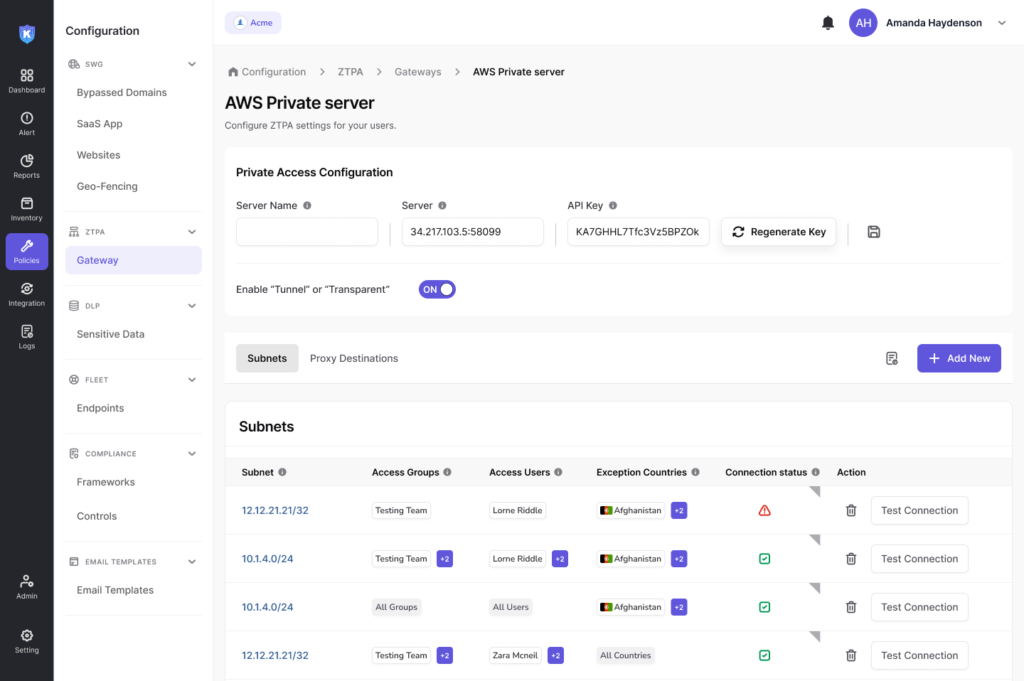
Kitecyber Infra Shield is one of the top ZTNA solutions that promotes Zero Trust at its core. It modernizes access to private apps, ditching legacy VPNs for identity-based verification. Self-host or SaaS. Infra Shield stands out with elegant cross-platform agents, clear pricing, deep posture checks, and first-class analytics. It’s built for B2B environments with advanced compliance needs.
Features:
- Zero Trust Private Access for secure app connections.
- Passwordless auth
- Device-trust checks
- AI threat blocking
- BYOD infra keys
- AD/SSO, API
- Multi-tenant MSP
- IPv6 & DoH
- Compliance toolkit
Pricing (As of 2025): $5 per month per user (Upto 10 users) for Single-cloud and $7 per month per user for Multi-cloud Infrastructure. See Kitecyber Infra Shield pricing here: pricing.
Whom it’s for: Security-conscious SMBs, MSPs, and cloud-first teams needing modern zero-trust across Multi-OS devices.
Client reviews: Kitecyber has been rated highly on G2, Software Advice, GetApp, and Capterra.
Whom it’s for: Security-conscious SMBs, MSPs, and cloud-first teams needing modern zero-trust across Multi-OS devices.
Client reviews: Kitecyber has been rated highly on G2, Software Advice, GetApp, and Capterra.
Why Customers Choose Kitecyber Infra Shield as top ZTNA Solution & Vendor?
Organizations choose Kitecyber Infra Shield because it delivers full-stack zero-trust security, passwordless, device-trust-aware, analytics-rich, at a price and speed traditional zero trust vendors can’t match. Its platform is designed for organizations that require:
1. Passwordless Zero-Trust in Minutes—not Months
Kitecyber Infra Shield replaces broad VPN tunnels with identity- and device-verified access that’s live in under 10 minutes—no appliances, IP whitelists or complex PKI required. Admins simply connect their IdP, deploy the lightweight agent (Windows, macOS, Linux) and set compliance policies from a single dashboard.
2. Transparent, SMB-Friendly Pricing
Customers switching from Perimeter 81 or Cisco report up to 60 percent cost savings because every feature is unlocked at one predictable per-user rate (US$5–$7/user/month on average). There are no PoP bandwidth fees or “premium support” surcharges.
3. Always-Available Human Support
24/7 chat, phone and email support is included for all tiers—no gated escalation paths. Multiple customer quotes highlight instant responses and hand-held migrations as a key reason for choosing Kitecyber over larger incumbents.
4. Built for Multi-OS, BYOD & MSP Use Cases
Infra Shield’s agent and web portal are designed for mixed mac, Windows, Linux and mobile fleets plus multi-tenant management for service providers. IT teams onboard contractors or entire client organizations without spinning up new gateways.
Here’s what Venkat Thiruvengadam, CEO at DuploCloud says about our solution:
Here’s what Venkat Thiruvengadam, CEO at DuploCloud says about our solution:
Kitecyber helped us with IT, security and compliance as a unified solution. It saved us almost 50% in overall cost as compared to our previous solutions, while significantly improving our security and compliance. the builtin device management and IAM integrations, also optimized our onboarding and offboarding workflows.

Venkat Thiruvengadam
CEO, Duplocloud
2. Zscaler Private Access
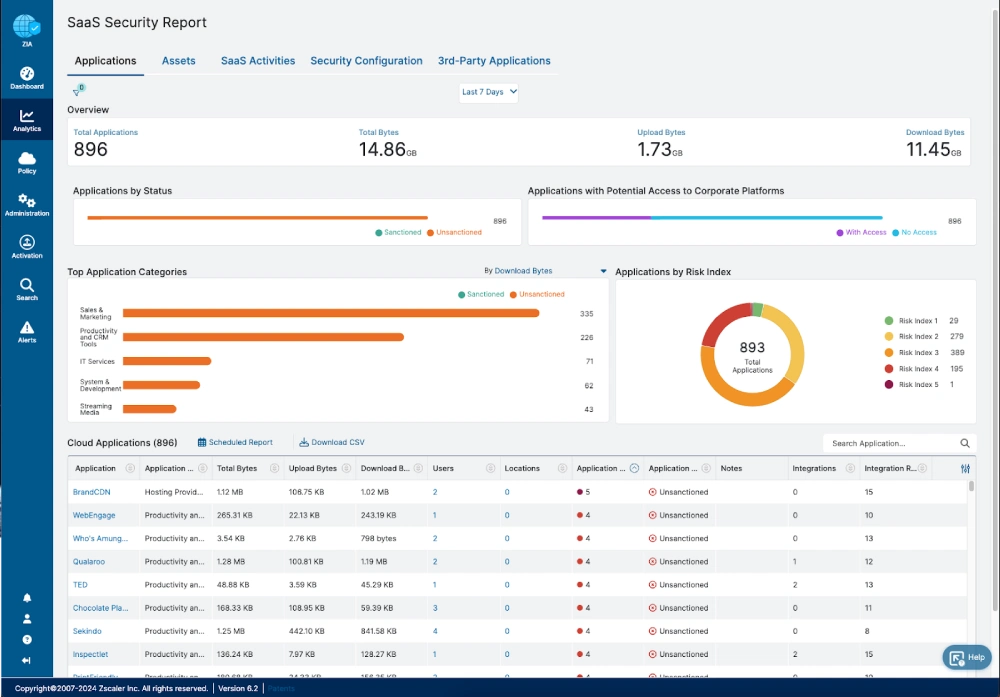
Zscaler Private Access is a cloud-native ZTNA platform connecting users directly to apps. It verifies context continuously, reducing lateral movement risks. The solution scales for distributed workforces. It integrates with threat intelligence for proactive defense. Organizations simplify access without exposing networks.
Features:
- Secure Web Gateway for traffic filtering.
- Cloud Access Security Broker for visibility.
- Dynamic Access Policies based on context.
- Multi-Factor Authentication support.
- Split-Tunneling for optimized performance.
- Integration with IAM providers.
- Real-Time Threat Detection.
- Granular Policy Enforcement
Pros: High scalability. Seamless hybrid access. Strong threat prevention.
Cons: Limited POP locations worldwide, Data Sovereignty issues for regulated space. Can be complex for small teams. Higher learning curve.
Pricing (As of 2025): $10-15/user/month.
Whom it’s for: Large enterprises with global teams.
Cons: Limited POP locations worldwide, Data Sovereignty issues for regulated space. Can be complex for small teams. Higher learning curve.
Pricing (As of 2025): $10-15/user/month.
Whom it’s for: Large enterprises with global teams.
3. Palo Alto Networks Prisma Access
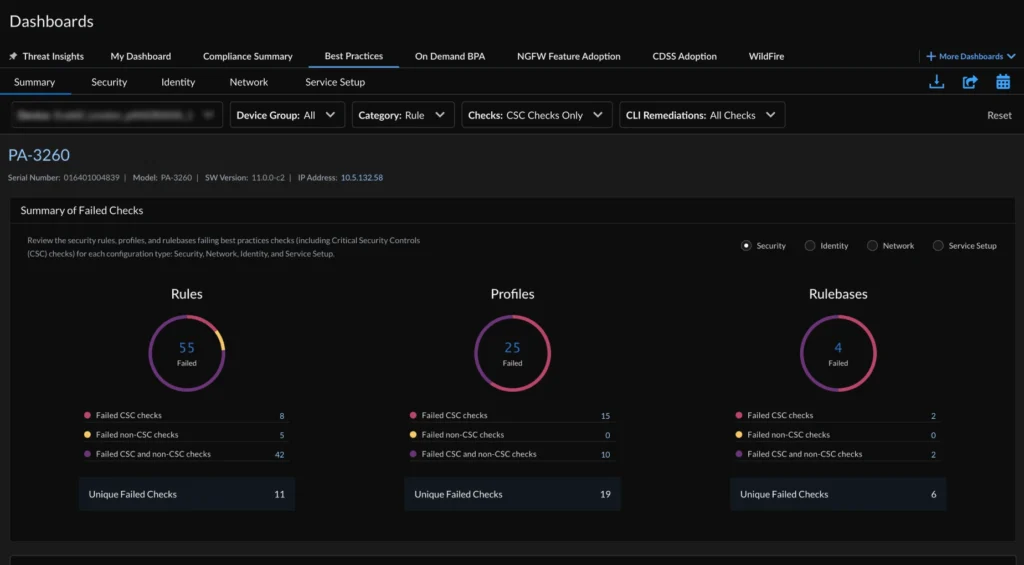
Palo Alto Prisma Access offers cloud-delivered ZTNA within a SASE framework. It secures remote and on-site users with consistent policies. Advanced threat prevention stops attacks in real-time. The platform supports hybrid work. It addresses ZTNA 1.0 limitations with finer controls.
Features:
- Secure Web Gateway with malware blocking.
- Firewall as a Service for threat prevention.
- Cloud Access Security Broker integration.
- ZTNA 2.0 for app protection.
- URL Filtering and DNS Security
- Sandboxing for zero-day threats.
- Context-Aware Access.
- Centralized Management.
Pros: Comprehensive security suite. AI-driven URL filtering. Excellent for complex needs.
Cons: Higher cost. Requires expertise.
Pricing (As of 2025): $12-20/user/month.
Whom it’s for: Enterprises with multi-cloud setups.
G2 Rating: 4.6/5
Cons: Higher cost. Requires expertise.
Pricing (As of 2025): $12-20/user/month.
Whom it’s for: Enterprises with multi-cloud setups.
G2 Rating: 4.6/5
4. Cloudflare Zero Trust
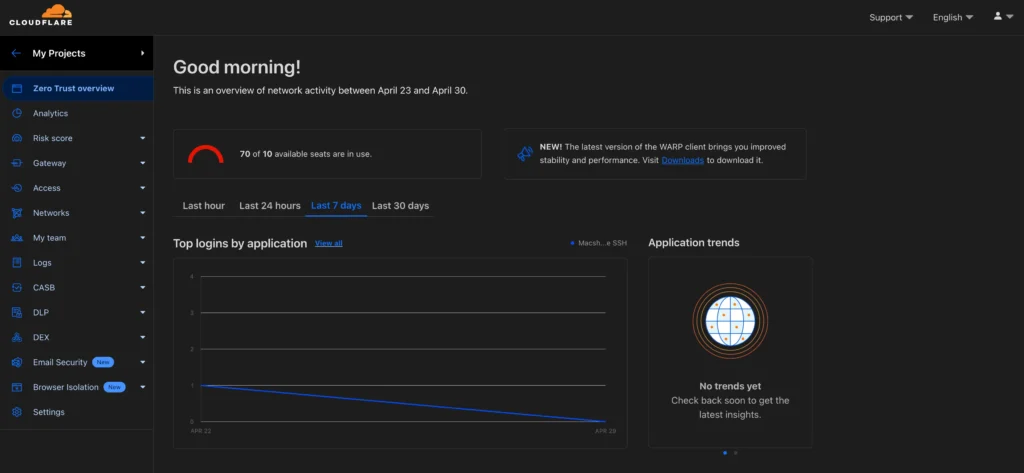
Cloudflare Zero Trust secures access without VPNs. It uses identity-based policies and device checks. The global network ensures low latency. It protects against email and web threats. Free tiers suit small teams.
Features:
- Secure Web Gateway for phishing protection.
- Magic WAN for branch connectivity.
- Magic Firewall for policy enforcement.
- Data Loss Prevention controls.
- Email Attack Protection.
- Unified Dashboard for management.
- Device Posture Monitoring.
- SSO Integration.
Pros: Fast deployment. Scalable performance. User-friendly.
Cons: Less granular for on-prem apps. Dependency on Cloudflare ecosystem.
Pricing (As of 2025): Free tier; paid starts at $7/user/month.
Whom it’s for: Businesses of all sizes needing quick setup.
G2 Rating: 4.6/5
Cons: Less granular for on-prem apps. Dependency on Cloudflare ecosystem.
Pricing (As of 2025): Free tier; paid starts at $7/user/month.
Whom it’s for: Businesses of all sizes needing quick setup.
G2 Rating: 4.6/5
5. Netskope One
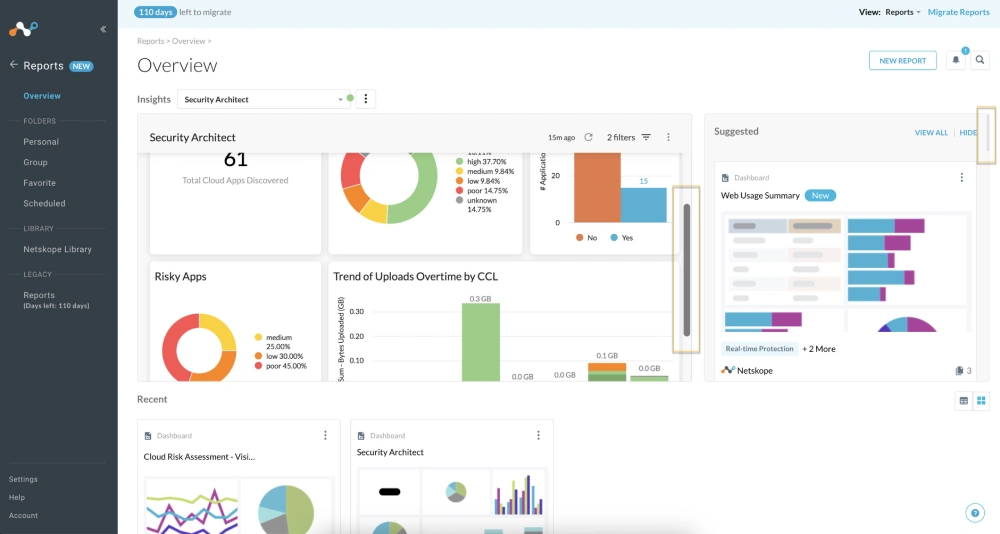
Netskope One provides data-centric ZTNA with cloud-native SSE. It secures remote access and third-party integrations. The platform focuses on SaaS and web threats. It offers seamless user experiences. Advanced analytics drive decisions.
Features:
- Cloud-Native Platform for scalability.
- Advanced Threat Protection.
- Data Loss Prevention.
- SSO and MFA Support.
- Real-Time Visibility.
- Granular Access Controls.
- Integration with SIEM.
- Behavioral Analytics.
Pros: Strong cloud focus. Easy management. Robust DLP.
Cons: Limited POP locations worldwide, Data Sovereignty issues for regulated space. May overwhelm SMBs. Pricing opacity.
Pricing (As of 2025): $10-18/user/month.
Whom it’s for: Cloud-heavy enterprises.
G2 Rating: 4.5/5
Cons: Limited POP locations worldwide, Data Sovereignty issues for regulated space. May overwhelm SMBs. Pricing opacity.
Pricing (As of 2025): $10-18/user/month.
Whom it’s for: Cloud-heavy enterprises.
G2 Rating: 4.5/5
6. Cisco Secure Access
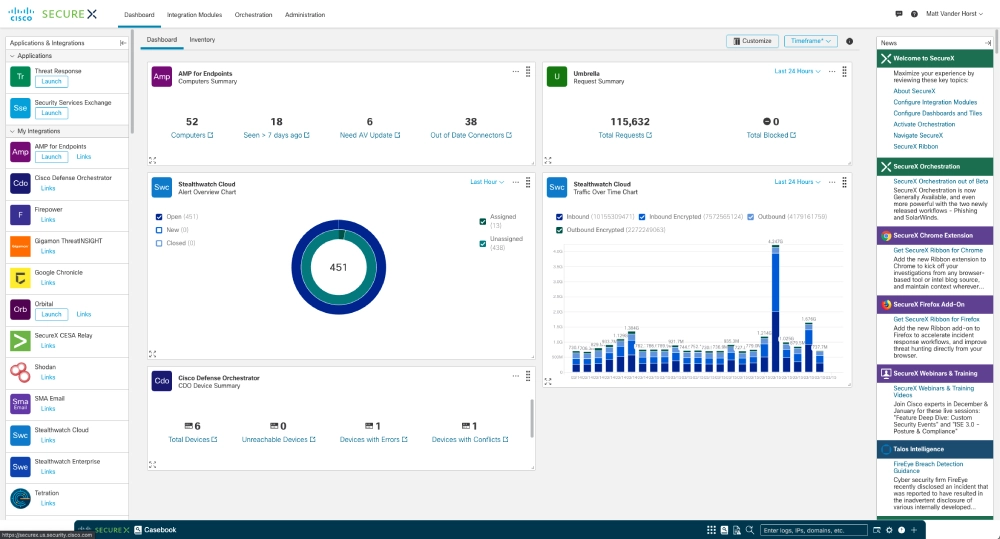
Cisco Secure Access combines ZTNA with SSE for comprehensive protection. It verifies users and devices continuously. The solution supports hybrid environments. Threat intelligence enhances defenses. It integrates with Cisco ecosystem.
Features:
- Identity Verification with SSO.
- Device Authentication.
- Granular Policies.
- Threat Intelligence Integration.
- Reporting and Analytics.
- API Support.
- Multi-Cloud Access.
- Endpoint Protection.
Pros: Reliable for Cisco users. Strong support. Versatile.
Cons: Vendor lock-in. Complex setup.
Pricing (As of 2025): $9-16/user/month.
Whom it’s for: Mid-to-large firms using Cisco tools.
G2 Rating: 4.4/5
Cons: Vendor lock-in. Complex setup.
Pricing (As of 2025): $9-16/user/month.
Whom it’s for: Mid-to-large firms using Cisco tools.
G2 Rating: 4.4/5
7. Fortinet FortiZTNA

Fortinet FortiZTNA integrates endpoint security with zero trust access. It provides VPN replacement with better protection. The single agent deploys easily. It shares health info for threat response. Centralized management simplifies ops.
Features:
- Zero Trust Agent with MFA.
- Central Management via Cloud.
- Split-Tunneling Support.
- Endpoint Protection.
- Vulnerability Scanning.
- URL Filtering.
- Active Threat Response.
- Compliance Reporting.
Pros: Unified agent. Cost-effective. Good for ransomware defense.
Cons: Agent required. Less agentless options.
Pricing (As of 2025): $8-14/user/month.
Whom it’s for: Organizations seeking endpoint-ZTNA combo.
G2 Rating: 4.7/5
Cons: Agent required. Less agentless options.
Pricing (As of 2025): $8-14/user/month.
Whom it’s for: Organizations seeking endpoint-ZTNA combo.
G2 Rating: 4.7/5
8. Check Point Harmony Connect
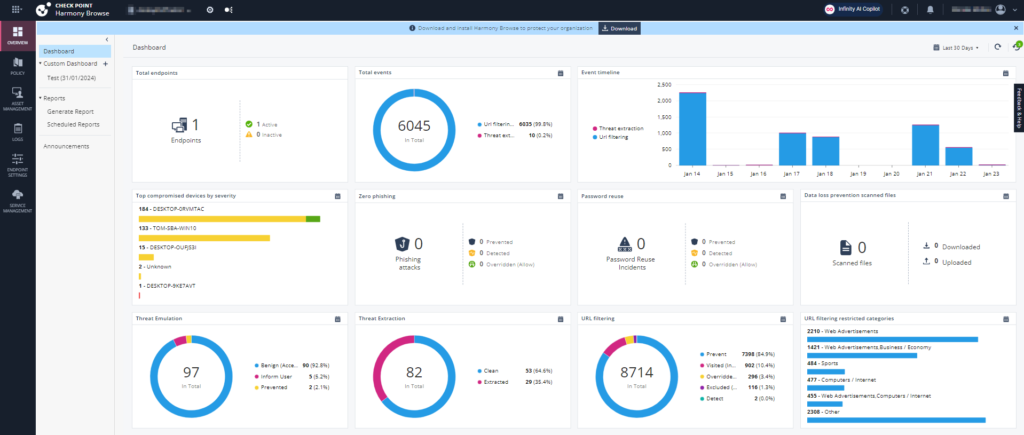
Check Point Harmony Connect delivers cloud-based ZTNA with malware protection. It secures global access quickly. Granular controls prevent breaches. The platform supports BYOD. It combines with SWG for full coverage.
Features:
- Adaptive Policies.
- Browser Isolation.
- SSO Integration.
- Threat Prevention.
- Device Posture Checks.
- Unified Console.
- Fast Deployment.
- Scalable Network.
Pros: Quick setup. Strong malware blocking. BYOD friendly.
Cons: Higher for small teams. Integration limits.
Pricing (As of 2025): $10-17/user/month.
Whom it’s for: Enterprises with distributed workforces.
G2 Rating: 4.5/5
Cons: Higher for small teams. Integration limits.
Pricing (As of 2025): $10-17/user/month.
Whom it’s for: Enterprises with distributed workforces.
G2 Rating: 4.5/5
9. Twingate
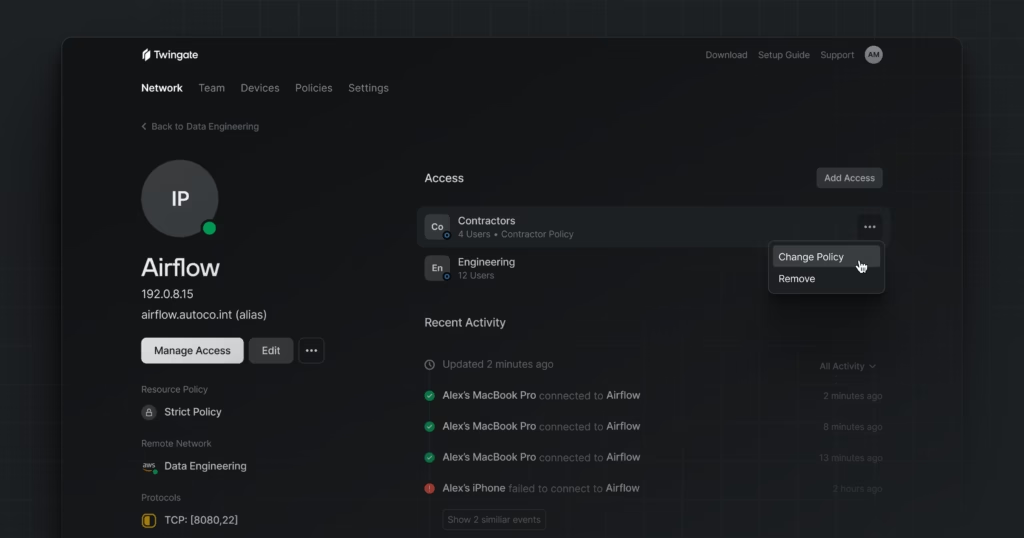
Twingate offers cloud-native ZTNA replacing VPNs. It deploys rapidly without infrastructure changes. Identity-based controls secure apps. The solution supports all devices. Low-latency access improves productivity.
Features:
- Per-Application Access.
- SSO and MFA.
- Network Segmentation.
- Encryption Everywhere.
- Device Posture.
- API/SDK Support.
- Unified Log Streamer.
- Low-Latency Performance.
Pros: Easy deployment. Affordable. Modern interface.
Cons: Less mature ecosystem. Limited advanced DLP.
Pricing (As of 2025): $5-12/user/month.
Whom it’s for: SMBs needing simple ZTNA.
G2 Rating: 4.8/5
Cons: Less mature ecosystem. Limited advanced DLP.
Pricing (As of 2025): $5-12/user/month.
Whom it’s for: SMBs needing simple ZTNA.
G2 Rating: 4.8/5
10. Perimeter 81
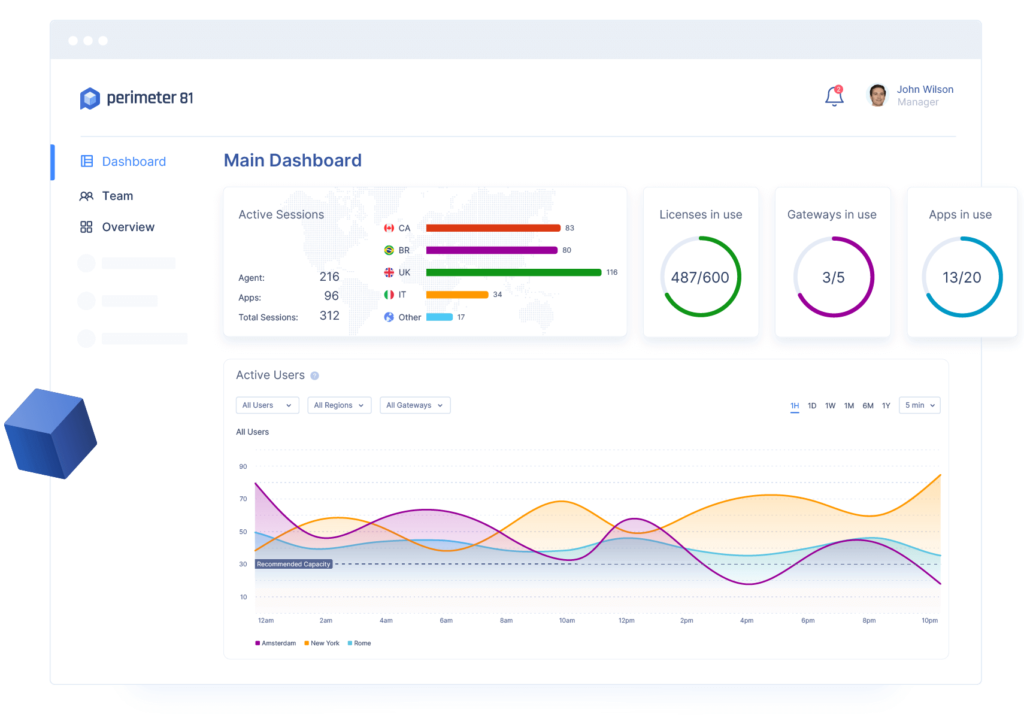
Perimeter 81 provides ZTNA with secure gateways. It enforces least-privilege access. The platform scales for remote teams. Integrations with IAM boost security. User-friendly dashboards aid admins.
Features:
- Identity-Centric Controls.
- Secure Gateways.
- Device Compliance.
- Network Visibility.
- SSO Support.
- Threat Detection.
- Multi-Cloud Integration.
- Policy Automation.
Pros: Scalable for growth. Intuitive. Good value.
Cons: Acquired by Check Point; potential overlaps. Less focus on endpoints.
Pricing (As of 2025): $8-15/user/month.
Whom it’s for: Growing SMBs and mid-market.
G2 Rating: 4.6/5
Cons: Acquired by Check Point; potential overlaps. Less focus on endpoints.
Pricing (As of 2025): $8-15/user/month.
Whom it’s for: Growing SMBs and mid-market.
G2 Rating: 4.6/5
How to Pick Your Best-Fit ZTNA in 2025
Choose the best ZTNA solution for 2025 based on your needs. For small to mid-sized businesses, pick Kitecyber Infra Shield. It offers affordable, easy deployment with strong protection. You get enterprise-grade features without complexity. Avoid overkill like Palo Alto.
Enterprises should go for Zscaler or Palo Alto. They provide scalability for global teams. Integrations and advanced analytics handle large-scale threats. You might pay more, but compliance and visibility justify it.
Cloud-first innovators in single-cloud setups benefit from Cloudflare. Its global network ensures fast access. Setup takes minutes. For multi-cloud, Netskope excels. It secures diverse environments seamlessly.
Act now. Assess your risks. Test a demo. Secure your mac, Windows, and Linux devices today. The right ZTNA vendor could save your business from the next big breach.
Enterprises should go for Zscaler or Palo Alto. They provide scalability for global teams. Integrations and advanced analytics handle large-scale threats. You might pay more, but compliance and visibility justify it.
Cloud-first innovators in single-cloud setups benefit from Cloudflare. Its global network ensures fast access. Setup takes minutes. For multi-cloud, Netskope excels. It secures diverse environments seamlessly.
Act now. Assess your risks. Test a demo. Secure your mac, Windows, and Linux devices today. The right ZTNA vendor could save your business from the next big breach.
With over a decade of experience steering cybersecurity initiatives, my core competencies lie in network architecture and security, essential in today's digital landscape. At Kitecyber, our mission resonates with my quest to tackle first-order cybersecurity challenges. My commitment to innovation and excellence, coupled with a strategic mindset, empowers our team to safeguard our industry's future against emerging threats.
Since co-founding Kitecyber, my focus has been on assembling a team of adept security researchers to address critical vulnerabilities and enhance our network and user security measures. Utilizing my expertise in the Internet Protocol Suite (TCP/IP) and Cybersecurity, we've championed the development of robust solutions to strengthen cyber defenses and operations.
Posts: 43
